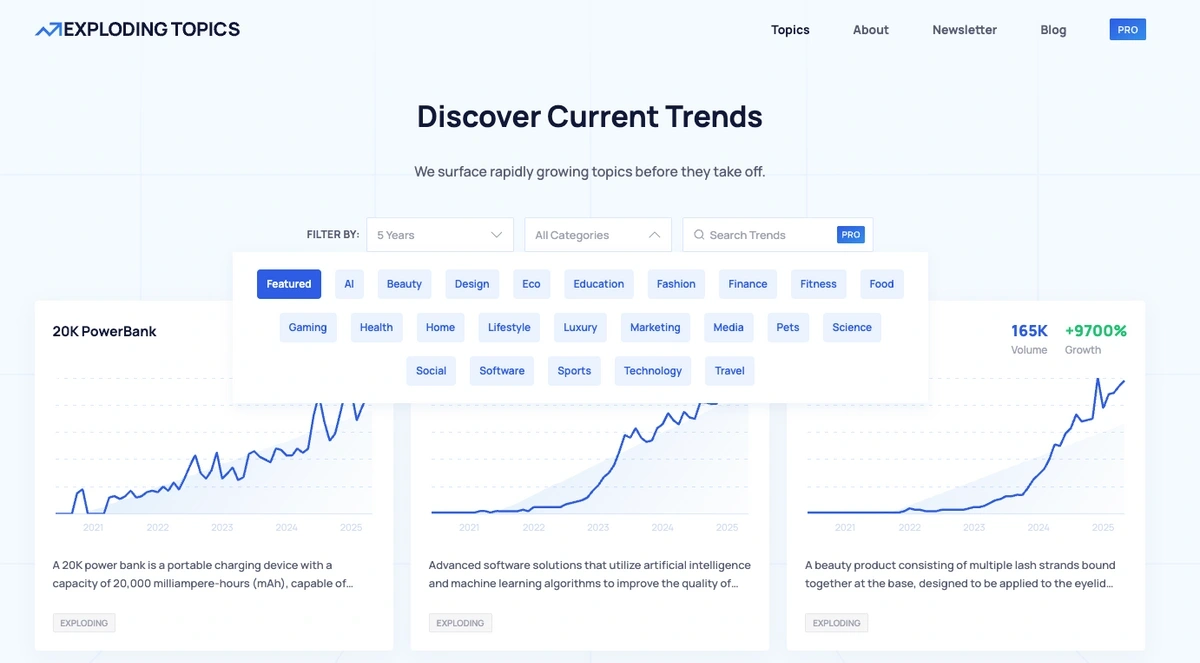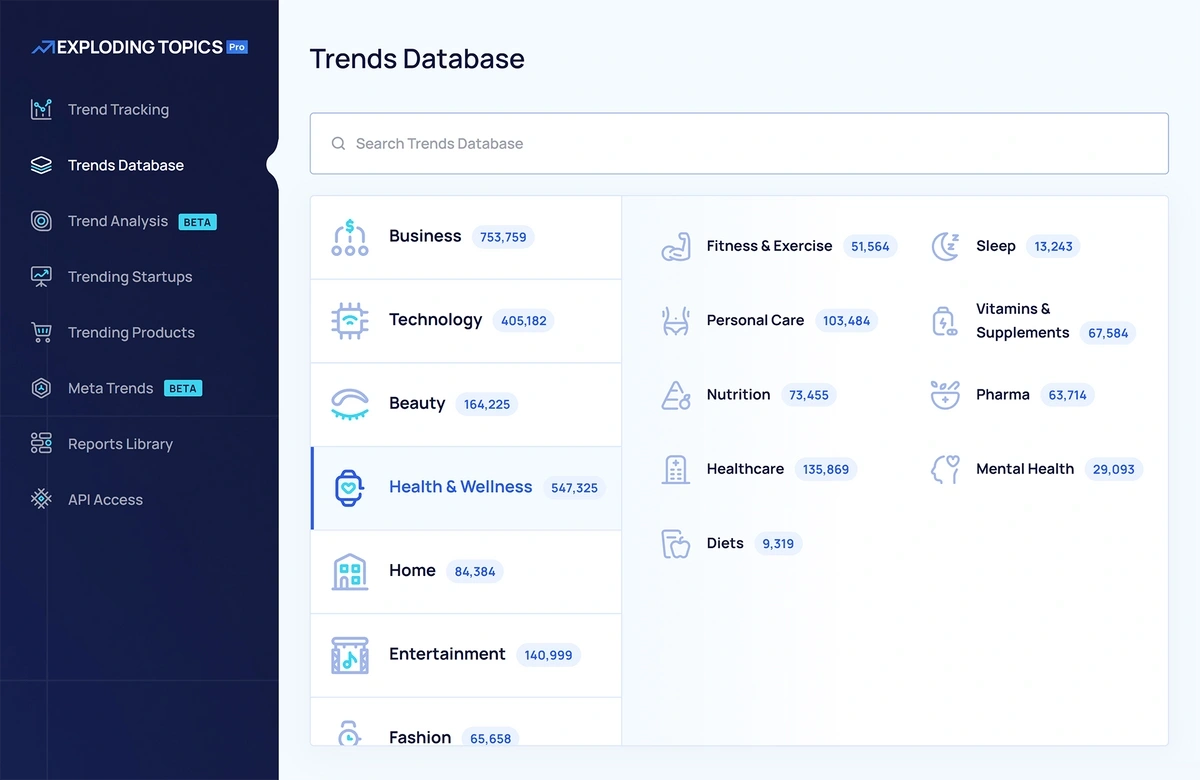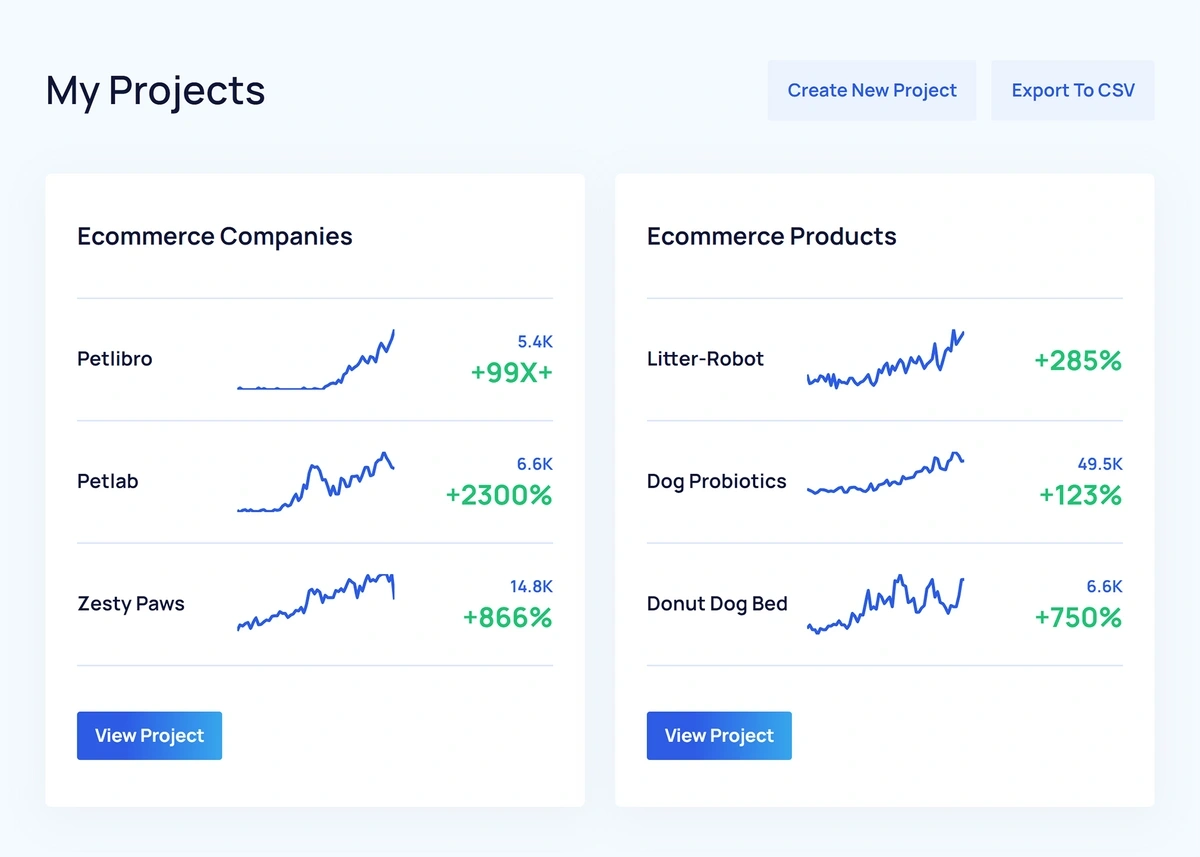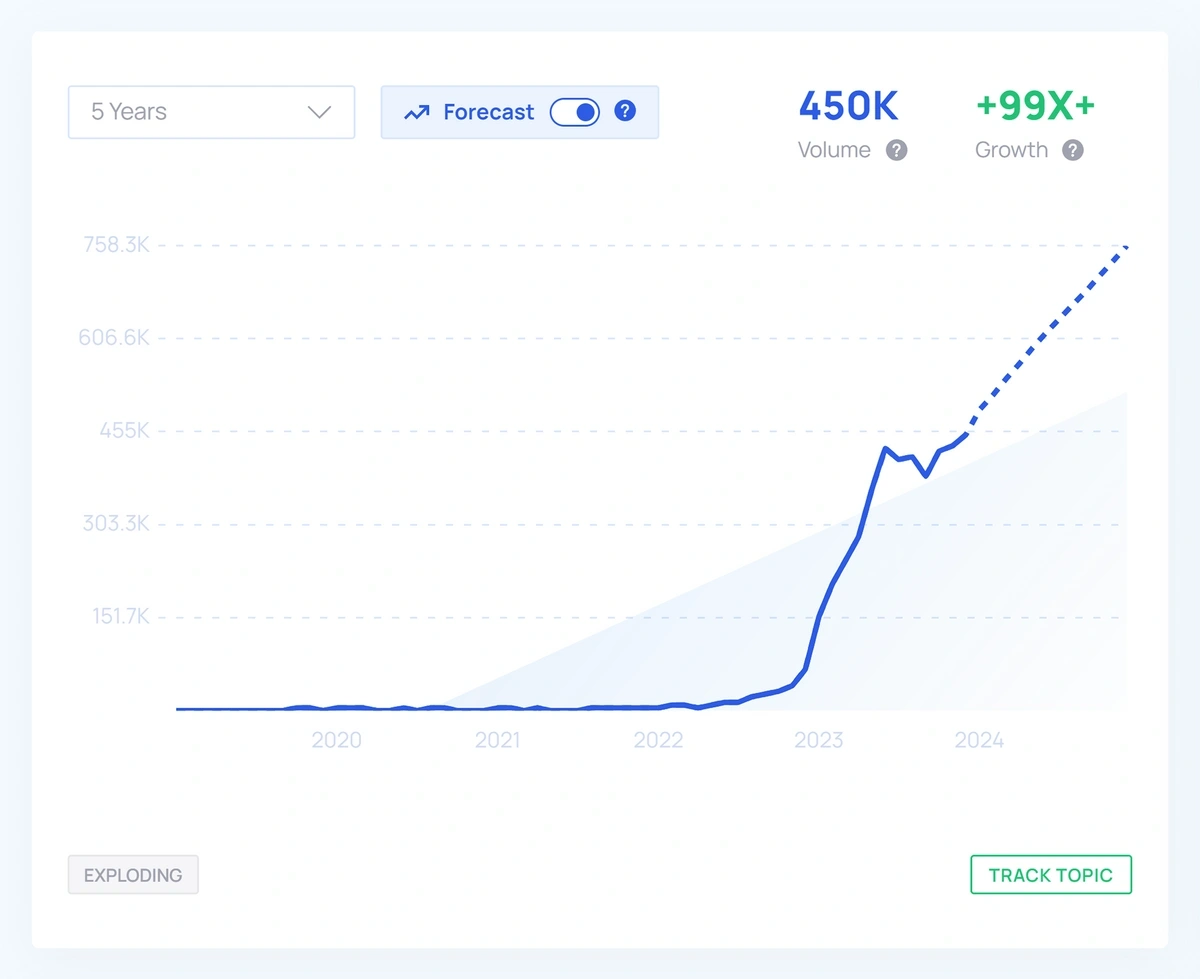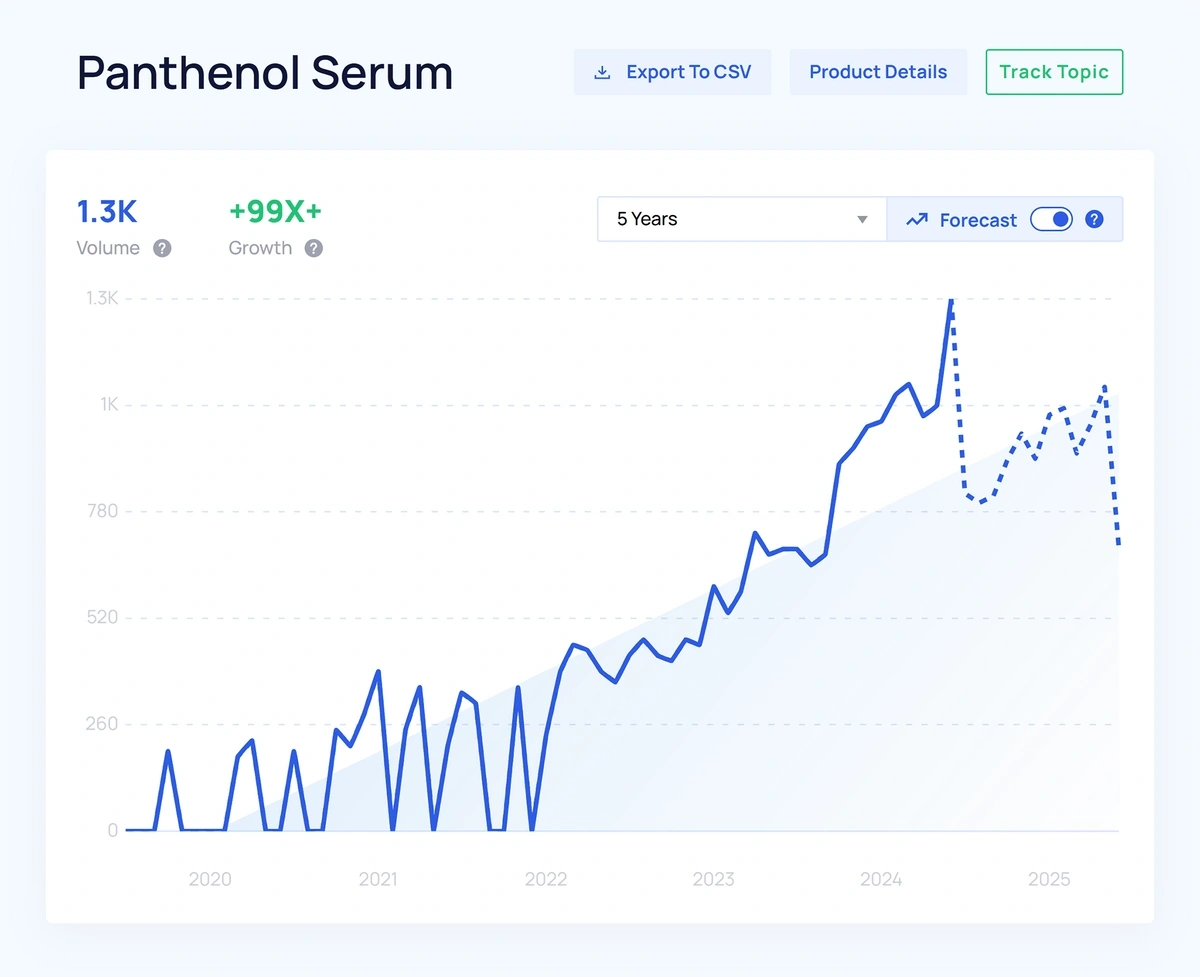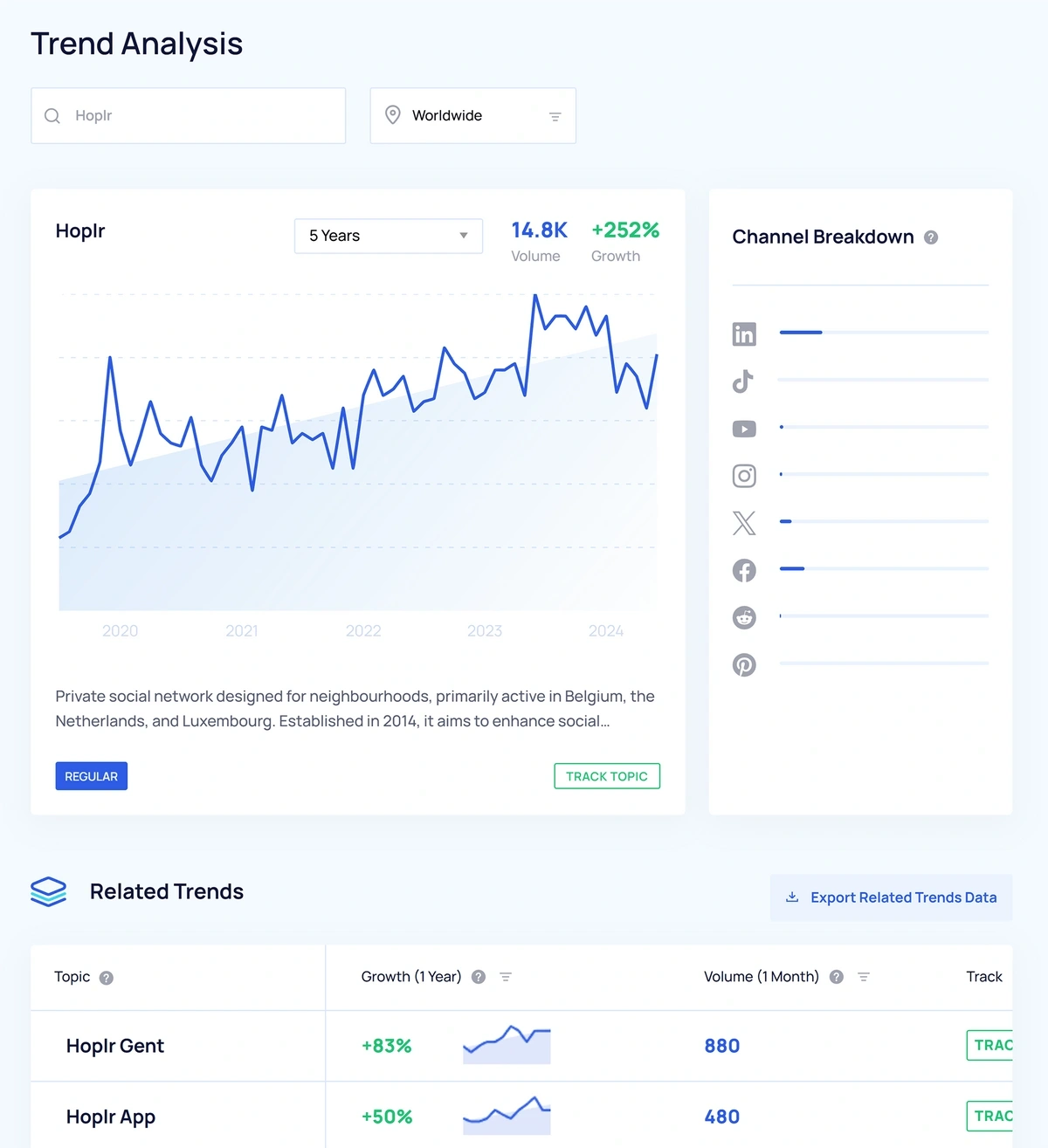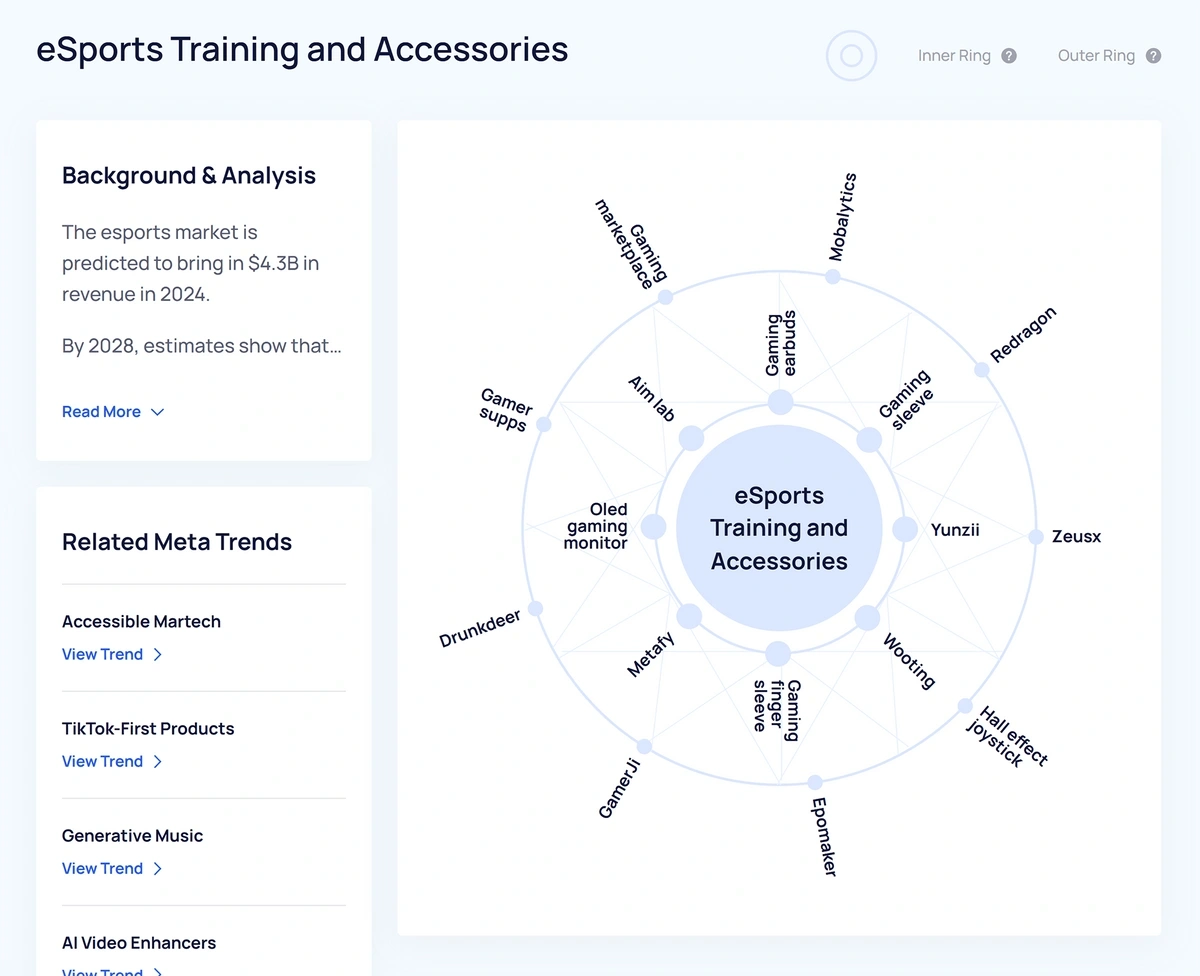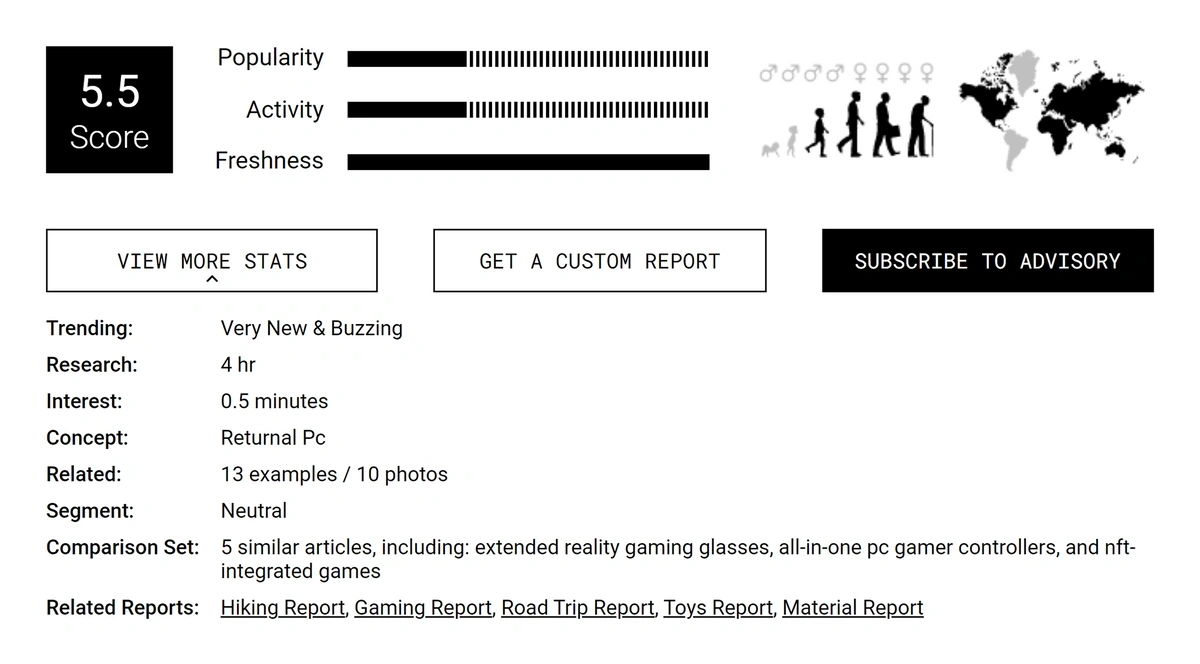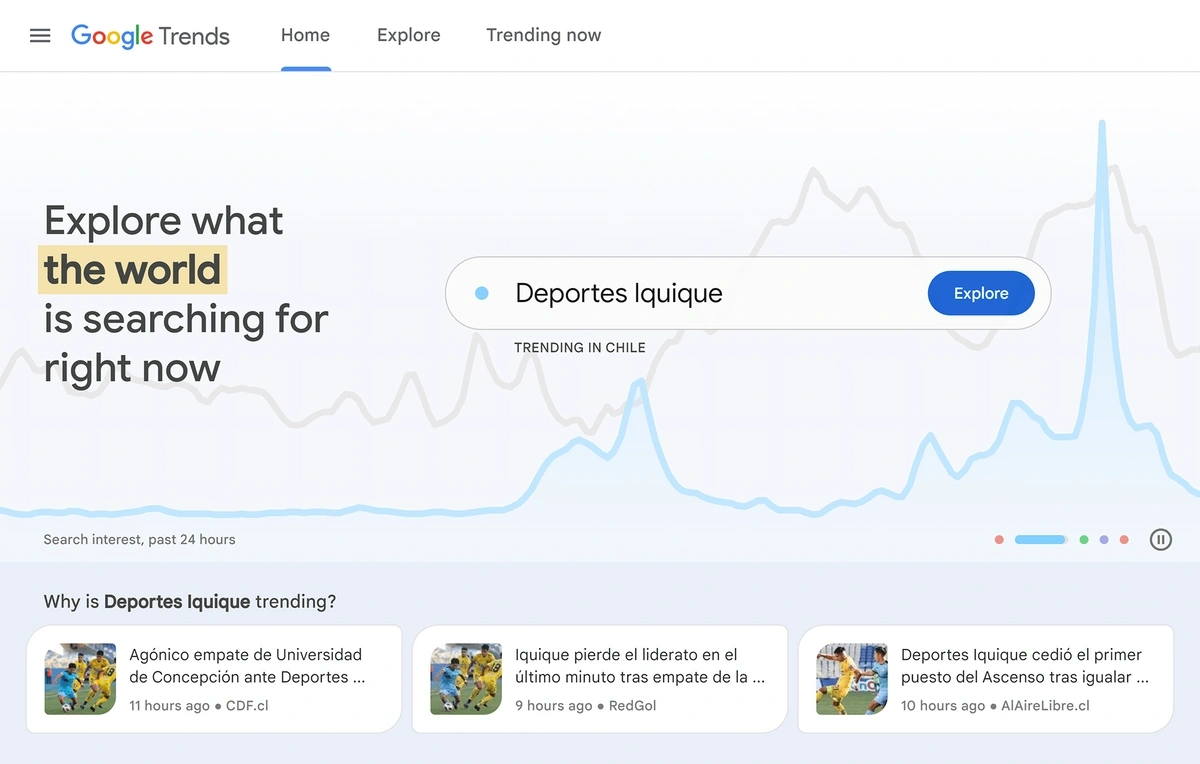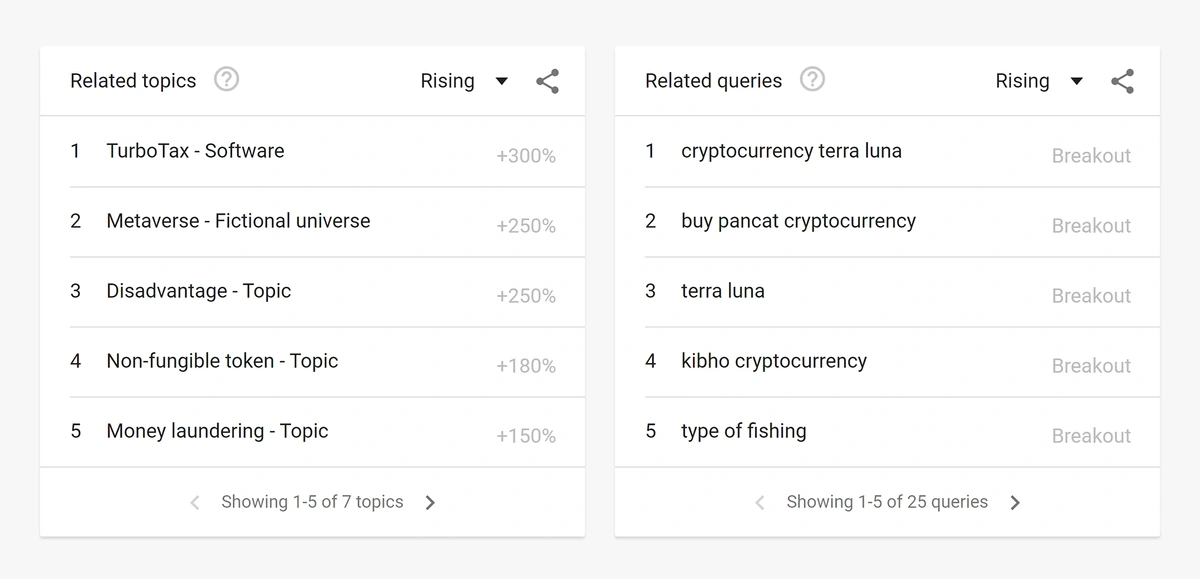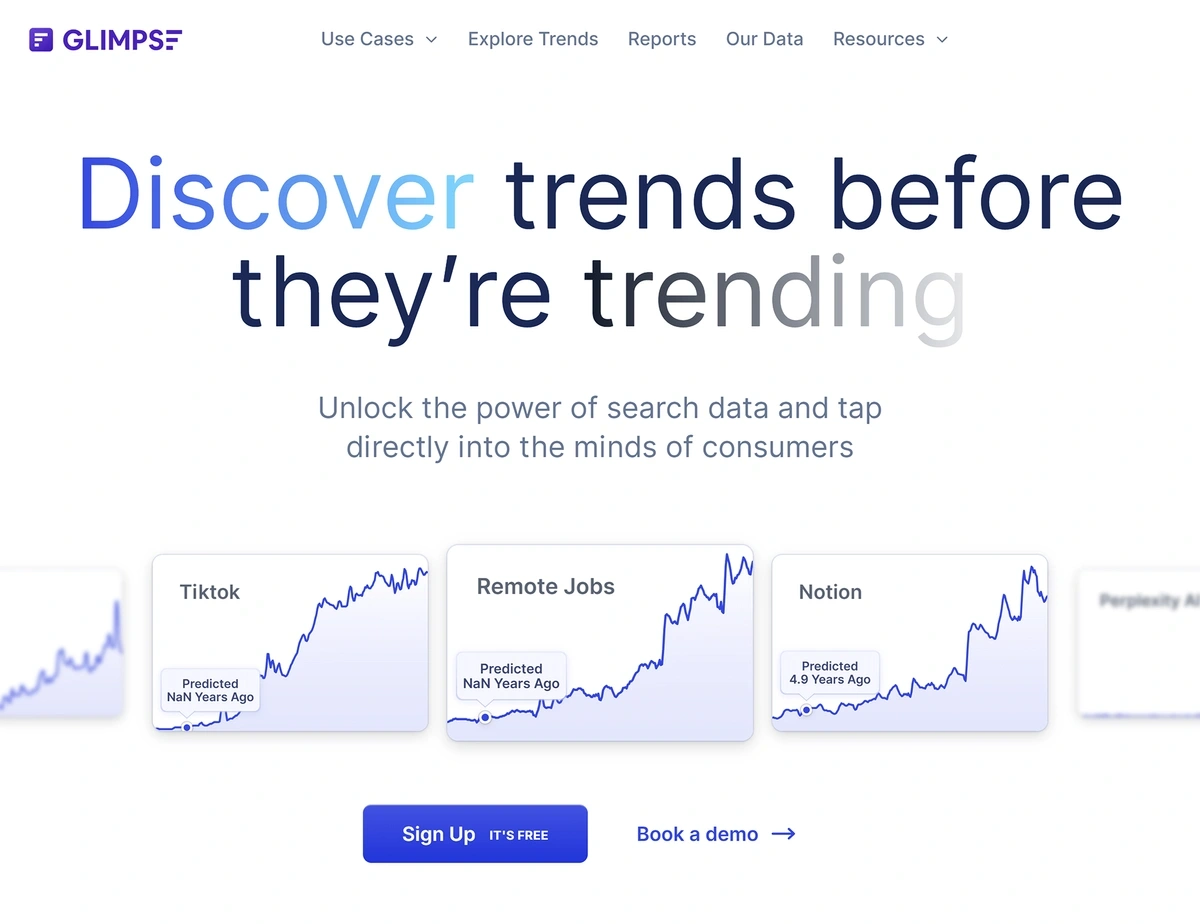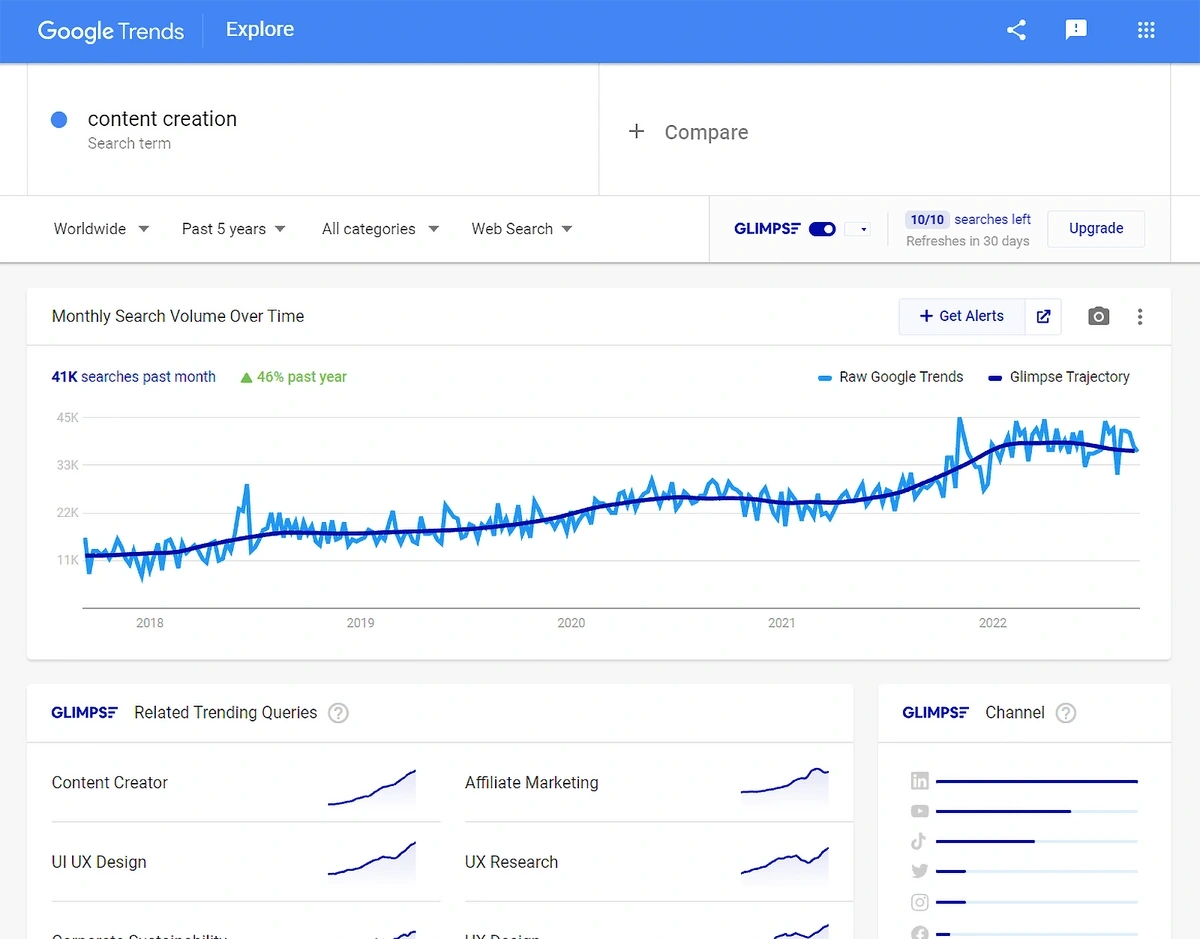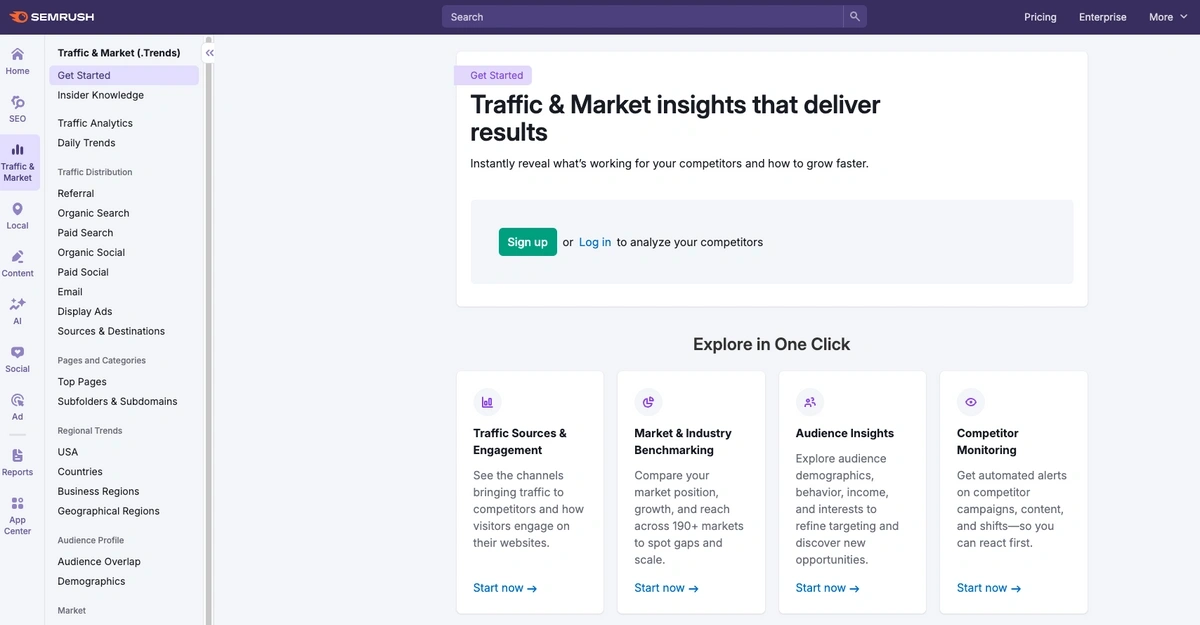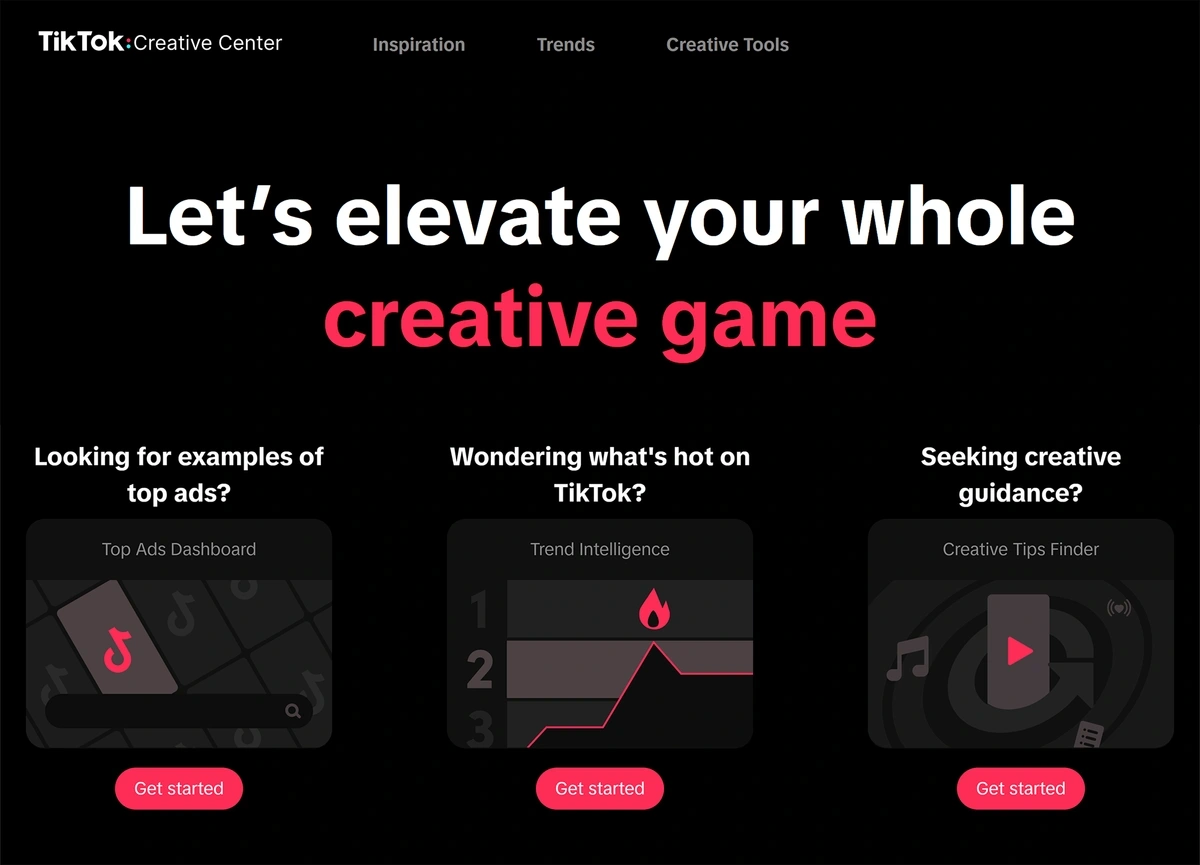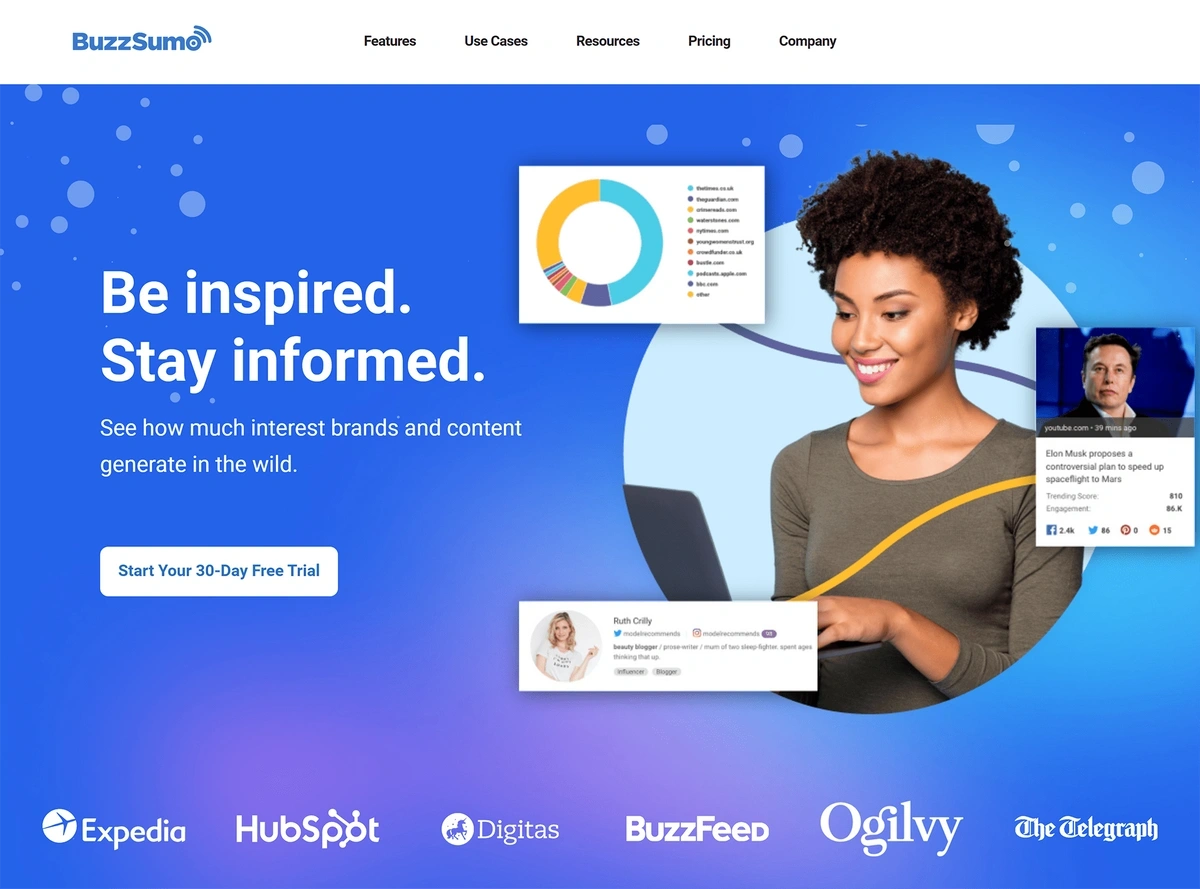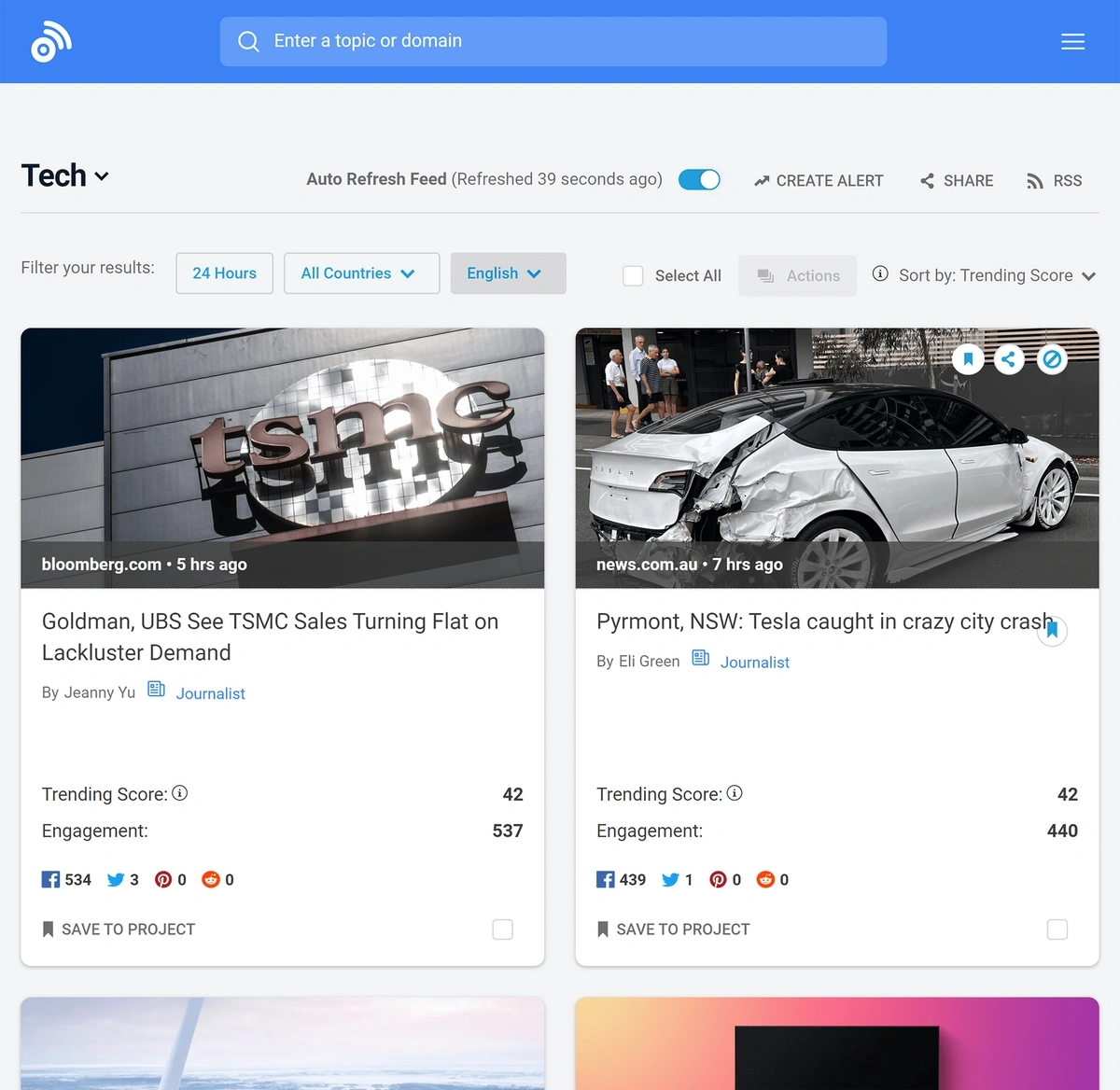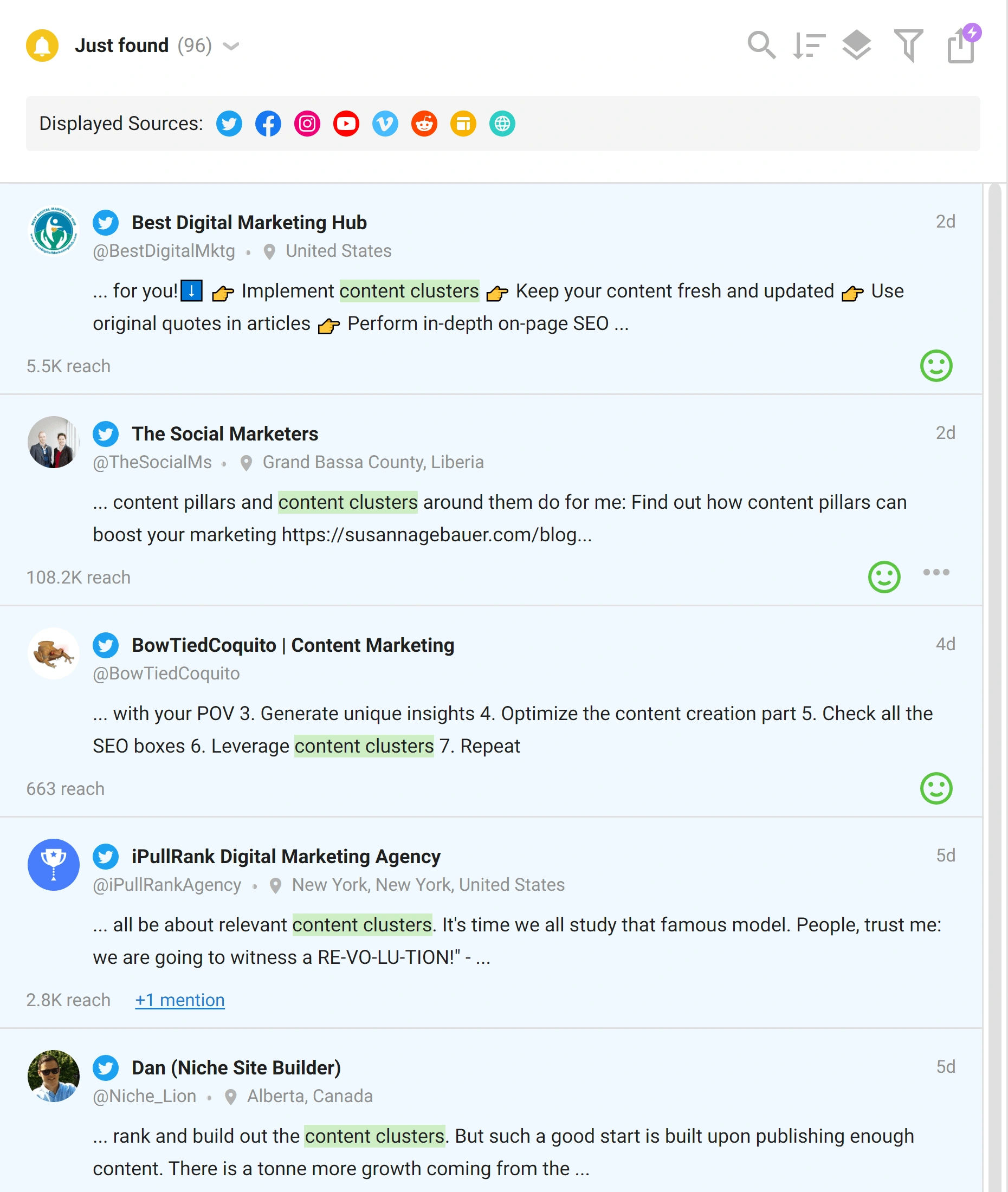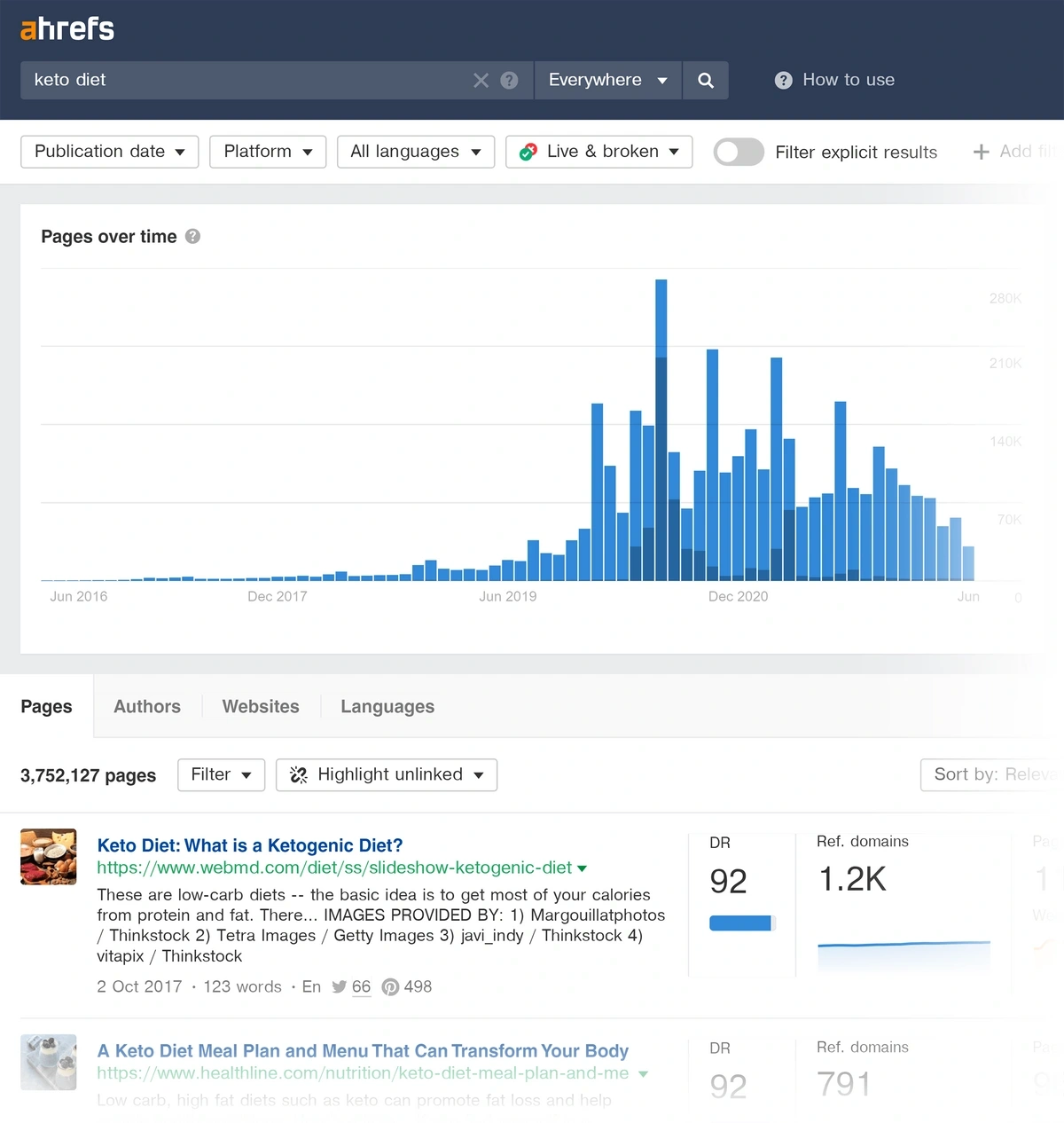
How to Find Trending Topics: Free and Paid Tools
You can find trending topics by browsing social media platforms, industry websites, and forums like Reddit and Quora.
However, you'll soon discover that this trend discovery process can be time-consuming and inefficient.
It might take you hours to discover just one promising trend.
Even then, you'll still have to do more research to uncover data to prove it's a trend with promising potential rather than a fad that will disappear in a few months.
So instead of time-consuming methods to manually dig through data to find trending topics, we'll show you to a handful of the most popular trend discovery tools that do the hard work of finding trending topics for you.
1. Exploding Topics
We tried a number of trend discovery platforms, and after failing to find one that found trends early on. So we decided to build Exploding Topics.
Below, we'll give you an overview of how it works, and then we'll discuss how it checks the boxes of the four criteria outlined above.
How Exploding Topics Works
Exploding Topics' flagship feature is the Trends Database, a searchable database of over 1M trending topics.
You can sort the database by category (e.g., beauty, finance, food, gaming, retail) and filter by trend growth status (Exploding, Peaked, and Regular), which is determined by Google search data.
If you find an interesting trend, you can save it to a Project by clicking "Track Topic." Projects live in the main dashboard and make it easy to monitor a trend's growth status over time.
Exploding Topics offers a handful of other features as well.
However, let's first discuss how each trend is sourced and qualified, as this is a significant reason why Exploding Topics is a premium trend discovery tool.
How Exploding Topics Identifies and Qualifies Trends
A key differentiator between Exploding Topics and other trend tools is that it uses a combination of AI and human analysts to find and approve topics before adding them to the Trends Database.
Here's how it works:
- AI scrapes data from sources like Reddit, Quora, Google Search, Amazon, YouTube, podcasts, and other news sources to identify popular topics. It then flags popular topics for human analysis.
- A human then researches each flagged topic and approves only those that have shown steady growth over an extended period of time and have business value.
AI is perhaps the most effective method for creating a thorough list of trending topics, as it can quickly scrape millions of web pages.
So while AI is unlikely to miss any promising trends, the downside is that it will also probably capture a lot of irrelevant topics too.
For example, it will likely pull a lot of pop culture topics like movies, celebrity news, or songs that have little to no business value.
So our "secret sauce" to providing only high-quality trends is using a human analyst to confirm each topic has business value.
This way, you don't waste time sifting through irrelevant topics and only see highly-quality industry trends.
In addition, we wanted to use data to qualify each industry trend. So instead of just adding any trends that our analysts find interesting or using data from a limited sample size, we use Google search volume to determine trend growth.
Google Search volume is perhaps the most reliable method to measure trend growth as it measures the global population's interest in that keyword for as far back as 10 years.
If a keyword has shown steady growth over the past several years (the default is five years), it will probably continue to grow for years to come. While this isn’t always the case, we’ve found search data to be the most reliable data to gauge a trend’s potential.
In fact, we also include a forecast feature that uses a time series machine learning algorithm to project future growth:
Additional Features
The Trends Database is our flagship feature, though you'll also find a handful of other helpful features that make it easy to identify and confirm trends. Here are a few of them:
Trend Analysis
The main value of Exploding Topics is that it brings trends to your attention (including trends you weren't aware of yet).
However, we realize you might already have a topic in mind and just want to see whether or not it's trending. So with Trends Search, you can type in any keyword and generate a report of its historical search volume trend in real time along with other related topics:
Meta Trends
When a new popular product or company enters the market, it's often due to a broader industry trend. For example, the explosive growth that companies like Beastcoast and Fnatic are experiencing is likely thanks to the growth of the larger Meta Trend, eSports training.
So to help you uncover the more encompassing industry trend, we built Meta Trends.
Criteria Overview
As we mentioned earlier in this post, we'll evaluate each tool based on the following criteria. So here's how Exploding Topics stacks up:
Time and effort: The Trends Database lets you find relevant industry trends in seconds. Simply sort by category, and you'll have instant access to dozens (if not hundreds) of promising industry trends.
Relevancy: A human analyst manually vets each trend before adding it to the Trends Database, so each trend is guaranteed to be relevant to its category.
Thoroughness: Exploding Topics uses AI and machine learning to scrape millions of web pages. Specifically, it pulls from sources like Google Search, ecommerce sites like Amazon, podcasts, social media, YouTube, and industry publications.
Data reliability: Exploding Topics uses Google search data to determine the growth status of each trend. We've found this is the most reliable method to predict a trend's future growth as it pulls data from the global population's search activity.
Want to Spy on Your Competition?
Explore competitors’ website traffic stats, discover growth points, and expand your market share.
2. Trend Hunter
Trend Hunter offers a database of trends that allows you to search by topic (e.g., Fashion, Tech, Culture, Design).
If you find an interesting trend, you can click on it to see a basic definition and a handful of images.
So how does Trend Hunter determine whether or not a topic is a trend?
First, it uses AI to scrape the web and find new topics. If the team thinks the topic is interesting, they add it to the trend database.
(Similar to how Exploding Topics works),
Once a topic is added, you'll see the following metrics:
- Popularity: This score is calculated based on how many Trend Hunter users upvote the topic.
- Activity: This score is calculated based on the clicks the topic receives weekly.
- Freshness: This score is calculated based on how recently it was added to Trend Hunter's report.
Note that these scores are calculated in relation to other trends inside the Trend Hunter database. For example, if the average trend in Trend Hunter's database receives 200 clicks per week from Trend Hunter users, a trend with 300 clicks per week from Trend Hunter users would have a high activity score.
So while this data may be interesting, it isn't particularly reliable as it is based solely on Trend Hunter's user data.
Criteria Overview
Here's how Trend Hunter levels up with the criteria we established earlier:
Time and effort: You can find new trends in a few minutes – just search a category and it will provide a list of various topics.
Relevancy: Trend Hunter allows you to sort by category and the topics in each category seem fairly relevant.
Thoroughness: It uses AI and machine learning to scrape the internet for topics, so there is a wide range of trends.
Data reliability: Perhaps the biggest issue with Trend Hunter is data reliability. First, topics added to the database are very recent. Many of them were first discovered by AI days ago. This can be a good thing. But the downside of only surfacing brand new trends is that it makes it difficult to predict whether that topic is a fad that will quickly dissipate or a promising trend that will continue to grow in popularity over the next several years.
Additionally, a trend's status is determined purely based on the Trend Hunter audience's engagement with that topic. Unfortunately, this is a very small sample size, and the audience likely isn't from your industry. So it's difficult to accurately assess your target market's interest in that trend based on this data.
3. Google Trends
Google Trends is a free tool that allows you to get trend data on any keyword, including:
- Search volume patterns (though not exact search volume metrics)
- Search demographic data
- Related topics suggestions
- Related queries suggestions
It is an excellent tool to explore search patterns of trends you know about, though there are more efficient tools for finding trends.
While some related topics and query suggestions are helpful, many are unrelated to the originally searched topic. For example, these are the suggested topics and queries for the term "cryptocurrency:"
Criteria Overview
Time and effort: The biggest issue with Google Trends is that it doesn't surface new trends for you. Instead, you have to find the topic first and then use Google Trends to look up its trend status.
Relevancy: Given that you must find the trends first, relevancy isn't really a factor.
Thoroughness: Given that you must find the trend first, thoroughness isn't really a factor.
Data reliability: Google Trends data is extremely reliable as it comes directly from Google. It also measures popularity from all Google searches across the globe, so you don't have to worry that the data is pulled from a sampled audience that isn't from your target demographic.
Get More Search Traffic
Use trending keywords to create content your audience craves.
4. Glimpse
Glimpse's main product is a Chrome extension called "Google Trends Supercharged" that augments Google Trends data.
So you can go to Google Trends, type in any topic, and in addition to all of the traditional data you'd receive from Google Trends, Glimpse will also give you access to:
- Exact search volume data (rather than just the trend data)
- Related trending topics
- Channels discussing that topic (TikTok, LinkedIn, Reddit, etc.)
- "People Also Search For" related results
- Topic map
To track a particular trend, you can create an Alert inside the Google Trends dashboard, and it will send you either an auto alert (triggered by a significant change in search traffic) or a recurring alert at a quarterly, monthly, or weekly cadence.
Glimpse also offers a database of trends for various categories. It gathers data by scraping sources like TikTok, Amazon, and Reddit and then provides a list of topics with search volume trends.
Criteria Overview
Time and effort: Glimpse allows you to browse 12 different trend categories (each with a handful of subcategories) and shows you a few topics for each category. Therefore, it's relatively easy to find new trends.
Relevancy: Glimpse does not state that they use human analysts to curate the trends added to categories, so you might have to sort through some noise to identify quality trends.
Thoroughness: It uses AI and machine learning to scrape the web for different topics, so you can expect a thorough list of trends.
Data reliability: It uses Google Search volume history to track trend growth status and allows you to sort by highest volume or highest growth.
5. Semrush Traffic & Market Toolkit (.Trends)
Semrush Traffic & Market Toolkit (.Trends) is a search tool that shows you the popularity of topics, companies, and websites.
The platform includes several features that let you get both a macro and micro view of trend changes in your industry.
- Traffic Analytics: Shows you how a specific website or product page has fluctuated in popularity (based on visits) over time.
- Market Overview: Displays trends' fluctuating market share, with related trends or companies displayed in an easy-to-read growth quadrant.
- EyeOn: Delivers automatic insights about the type of content your competitors create, and their posting frequency.
- Audience Profile: Shares demographic insights about the audiences engaging with the trends you're tracking.
When using these tools together, you can:
- Find trending topics in your industry
- Identify the competing companies attracting notice for products and services related to those trends
- Understand their audience
- Keep an eye on competitor activity
Because Semrush is, at its core, an SEO tool, our trends data is very focused on websites and search traffic.
If you need to see specific information about trends through other channels or social media platforms, you may be better served by another trend spotting tool on this list.
To get started, sign-up for a free Semrush account today.
Criteria Overview
Time and effort: You can quickly surface trend, traffic, and audience information through the toolkit, though you may need to run several reports using each of the Toolkit features in order to get all of the information you want.
Relevancy: Semrush updates its data monthly—so while you may not be getting daily trend updates, the information you see is still fairly recent.
Thoroughness: Toolkit reports include a lot of information that you may find useful to your research, including trending related keywords, popularity by location, and more.
Data reliability: Semrush uses reliable Google search information that's collected and analyzed with a proprietary algorithm.
6. TikTok Creative Center
The TikTok Creative Center is a platform-specific database of trending topics, videos, and accounts.
Once you locate a trending hashtag you're interested in, you can see associated information like:
- Post frequency
- Interest over time
- Audience demographics
- Regional popularity
- Related topics
- Popular related videos and creators
Because many people (especially Generation Alpha and Gen Z) turn to TikTok as their first source of information, this tool can be useful to you even if you aren't actively producing content for the platform.
And if you are marketing on TikTok, the insights you glean through the trend reports in Creative Center can help you get your content in front of your target audience.
Criteria Overview
Time and effort: The TikTok Creative Center landing page displays top trending hashtags and content, so it's very easy to quickly pick a topic and dive in.
Relevancy: The platform's trend data is updated regularly, so you can use it to get a good idea of what's popular among TikTok users right now.
Thoroughness: Each trending topic includes top-level information about audience demographics, regional popularity, and more—but TikTok doesn't drill down into each one as deeply as some of the other tools on this list do.
Data reliability: The data comes directly from TikTok, so you can have confidence in its accuracy.
7. Trends by HubSpot
Trends by HubSpot is a content site (mainly newsletters and articles) that cover topics that the editors believe will become important trends.
For example, one of their recent reports is about media leaders are taking advantage of generative AI.
Each article contains data-driven information like search volume trends, venture capital funding data, and market size statistics along with insight and analysis.
So while each article contains quality data, it's still not the most efficient method to find trends, as you'll have to scan through many articles to generate a list of trending topics.
Nevertheless, it is an excellent source to find a deep-dive article on a single industry trend.
Criteria Overview
Time and effort: You read through the reports to uncover new trends. While you can just skim the content, there aren't that many articles to sort through, so it's better for deep diving into a particular trend rather than discovering new trends.
Relevancy: The trends are manually curated and thoroughly researched, so they are highly relevant to each topic category.
Thoroughness: Each trend has a deep-dive report, so the content associated with the trend is very thorough. However, the downside of the deep-dive report style is that there are only a handful of trends in the database.
Data reliability: Their trend reports typically includes data to back up the trend. The only downside is that a human (rather than data) decides which trends to cover. This means that the topics selected for analysis aren't necessarily the most promising trends for that industry.
8. Buzzsumo
Buzzsumo is a content ideation tool commonly used by SEO and content marketing professionals. It offers a trending topics feature that scans social networks and aggregates the most popular posts published in the last 24 hours.
All trends are divided into feeds like News, Marketing, Tech, Science, and Business, though you can also create your own feeds based on a combination of general topics, domains, and/or countries.
The trends in the database are listed in order by their Trend Score, which is a proprietary calculation based on social shares over time. It also shows total engagement across Facebook, X, Pinterest, and Reddit.
As you can see, Buzzsumo is mainly designed to guide marketing campaigns. So while it doesn't provide specific trending topic suggestions, it does show you recently trending content in a particular industry across social platforms.
Criteria Overview
Time and effort: Buzzsumo is essentially a content aggregator – so you'll probably have to read multiple articles it surfaces to identify key trends.
Relevancy: Buzzsumo allows users to sort by category, though it's clear that many topics aren't particularly relevant to each category. For example, under the Tech category, you'll see in the screenshot above that there's an article on the Capitol riot investigation. For B2B users, this information isn't very useful.
Thoroughness: Buzzsumo scans Pinterest, Facebook, X, and Reddit to identify trends. So you'll only receive topic suggestions based on content that is popular on those specific social media platforms.
Data reliability: Buzzsumo determines trending topics based on the content's engagement data within the past days/weeks. So even if a topic is trending now, there's no guarantee that it will be trending in the next several years.
9. Awario
Awario is a social listening tool with a trending topic feature similar to Buzzsumo.
You can enter a general keyword (and negative keywords) into its search bar, and then Awario produces a list of content containing that keyword. The content sources it uses include:
- X
- Vimeo
- News/Blogs
- Web
Each list is ordered by recency, though it also includes total reach data. For example, below is a list of the most popular content for the term "content clusters." You can then click on any of the posts to read the full piece of content.
Awario's trending topics feature is primarily designed for content marketers who want to find popular content on a particular topic.
Criteria Overview
Time and effort: You have to think of the general topic you want to track, so you'll still have to manually search for topics yourself.
Relevancy: Awario shows you any post mentioning the keyword, so the posts may or may not be relevant to you. However, it does allow you to add negative keywords to refine notifications.
Thoroughness: Awario scans most of the web, including popular social media platforms, forums, and blogs, so it is a very thorough sample of data.
Data reliability: The posts that Awario surfaces are ranked by social media engagement and recency. Given that the content included is designed to be recent, a lot of what you uncover may be fads rather than sustainable trends.
10. Ahrefs Content Explorer
Ahrefs Content Explorer allows you to type in any topic and it will automatically pull up a list of the most popular pages and websites on that topic.
For each article, you'll be able to see the website's domain rating, the referring domains, page traffic, and traffic value.
You can also sort by news, publication date, and platform to filter the results.
You can then read through the most popular content to identify new industry trends or uncover new content ideas.
Criteria Overview
Time and effort: The Content Explorer is essentially a content aggregator, so you'll have to manually skim through the titles or read each piece to identify trends.
Relevancy: The content shown to you contains the keyword you searched for in the title. Therefore, most of the results are fairly relevant to the searched topic.
Thoroughness: The Content Explorer uses AI to analyze all the content across the web, so it's usually quite thorough.
Data reliability: Ahrefs uses its own traffic metrics and domain rating scores to determine what content to add to the Content Explorer.
Conclusion
Each of the tools on this list can help you uncover key data points about trending topics, competitors, and more—it's all a matter of choosing the right tool for your needs.
If you're searching for trends to support your marketing work, tools like Buzzsumo, TikTok Creative Center, and Semrush Traffic & Market Toolkit are all good choices.
But if you're interested in trend research for investment, product development, or other purposes, a more all-purpose tool like Exploding Topics will be a solid choice.
To learn more about finding trends to support your business operations, check out our complete guide to finding trends super early—and find the best topics before any of your competitors.
Stop Guessing, Start Growing 🚀
Use real-time topic data to create content that resonates and brings results.
Exploding Topics is owned by Semrush. Our mission is to provide accurate data and expert insights on emerging trends. Unless otherwise noted, this page’s content was written by either an employee or a paid contractor of Semrush Inc.
Share
Newsletter Signup
By clicking “Subscribe” you agree to Semrush Privacy Policy and consent to Semrush using your contact data for newsletter purposes
Written By


Josh is the Co-Founder and CTO of Exploding Topics. Josh has led Exploding Topics product development from the first line of co... Read more

